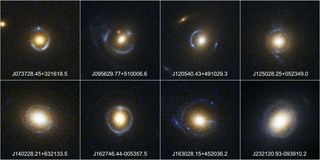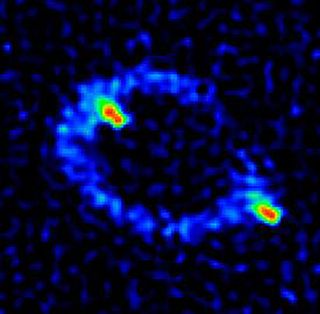Astronomers turn back time to solve Einstein ring mystery

Astronomers time traveled through archives of data to spot an object that made history in the 1980s and solve a long-standing cosmic mystery.
While practicing socially distant science, a group of researchers dug through old data from Keck Observatory on Mauna Kea in Hawaii and NASA's Chandra X-ray Observatory managed to spot a remarkable quasar, or an active galaxy emitting incredible amounts of light.
What they observed is actually an Einstein ring, or a ring of light that has been warped by the gravitational pull of a massive object between the quasar and Earth — a process called gravitational lensing. The light coming from the far-off galaxy warps around the object's large mass while on its way to Earth.
Related: Hubble telescope discovers light-bending 'Einstein ring' in space
But the team didn't just find any old Einstein ring, they spotted the first-ever discovered Einstein ring: 1131+0456. This object was first observed in 1987 using the Very Large Array network of radio telescopes in New Mexico. But when this object was discovered, it wasn't yet known how far away it was or what its redshift — a phenomenon in which objects moving away appear red because the wavelengths of light are stretched — is.
But with this new study, the team was able to determine the object's distance, and they found that it's 10 billion light-years away from Earth (or a redshift of z=1.849). Co-authors Daniel Stern, a senior research scientist at NASA's Jet Propulsion Laboratory in Pasadena, California, and Dominic Walton, an STFC Ernest Rutherford Fellow at the University of Cambridge's Institute of Astronomy in the UK, are the first to calculate the object's distance.

"The Berlin Wall was still up when this Einstein ring was first discovered, and all the data presented in our paper are from the last millennium," Stern said in a statement.
Get the Space.com Newsletter
Breaking space news, the latest updates on rocket launches, skywatching events and more!
"As we dug deeper, we were surprised that such a famous and bright source never had a distance measured for it," Stern added. "Having a distance is a necessary first step for all sorts of additional studies, such as using the lens as a tool to measure the expansion history of the universe and as a probe for dark matter."
This work was published June 1 in the journal The Astrophysical Journal Letters.
- The Universe: From the Big Bang to now in 10 easy steps
- 7 surprising things about the universe
- How the Hubble Space Telescope works (infographic)
Email Chelsea Gohd at cgohd@space.com or follow her on Twitter @chelsea_gohd. Follow us on Twitter @Spacedotcom and on Facebook.
<a href="https://www.space.com/your-favorite-magazines-space-science-deal-discount.html" data-link-merchant="space.com"" target="_blank">OFFER: Save 45% on 'All About Space' 'How it Works' and 'All About History'!
For a limited time, you can take out a digital subscription to any of <a href="https://www.space.com/your-favorite-magazines-space-science-deal-discount.html" data-link-merchant="space.com"" data-link-merchant="space.com"" target="_blank">our best-selling science magazines for just $2.38 per month, or 45% off the standard price for the first three months.
Join our Space Forums to keep talking space on the latest missions, night sky and more! And if you have a news tip, correction or comment, let us know at: community@space.com.

Chelsea “Foxanne” Gohd joined Space.com in 2018 and is now a Senior Writer, writing about everything from climate change to planetary science and human spaceflight in both articles and on-camera in videos. With a degree in Public Health and biological sciences, Chelsea has written and worked for institutions including the American Museum of Natural History, Scientific American, Discover Magazine Blog, Astronomy Magazine and Live Science. When not writing, editing or filming something space-y, Chelsea "Foxanne" Gohd is writing music and performing as Foxanne, even launching a song to space in 2021 with Inspiration4. You can follow her on Twitter @chelsea_gohd and @foxannemusic.

